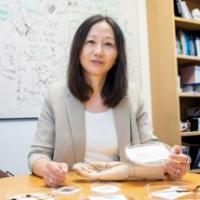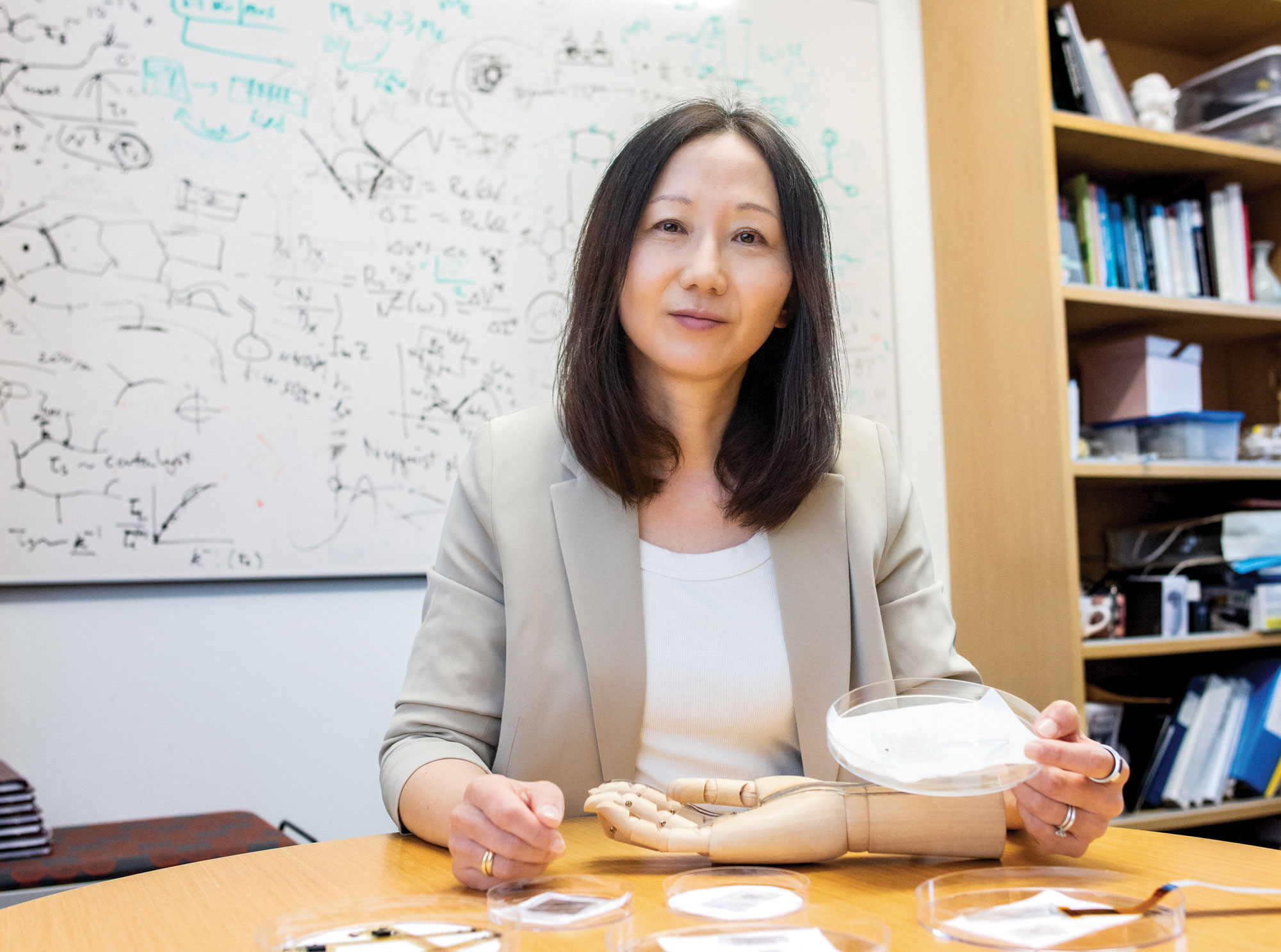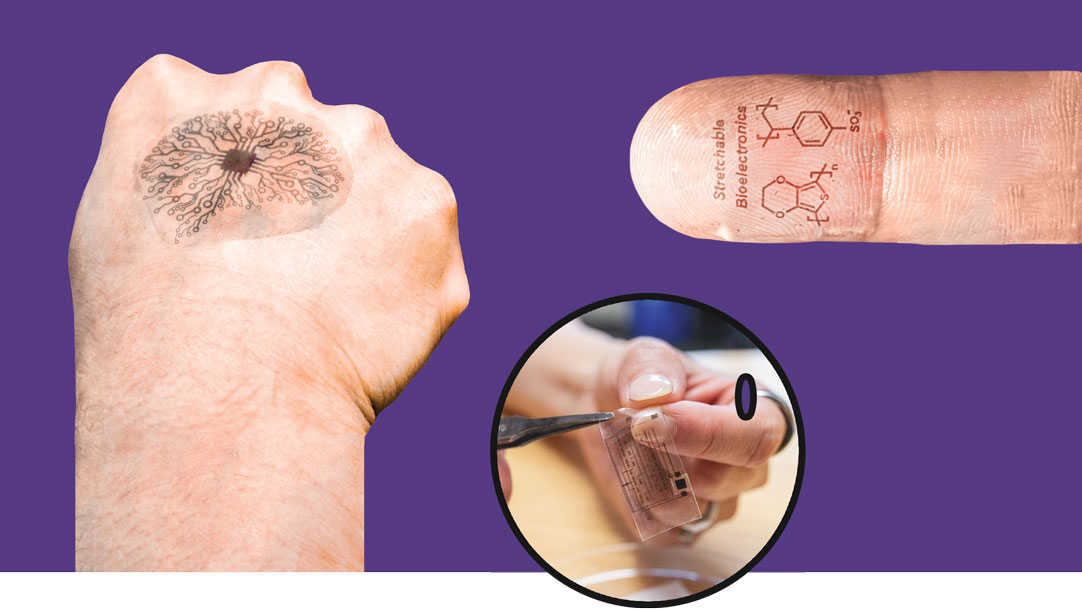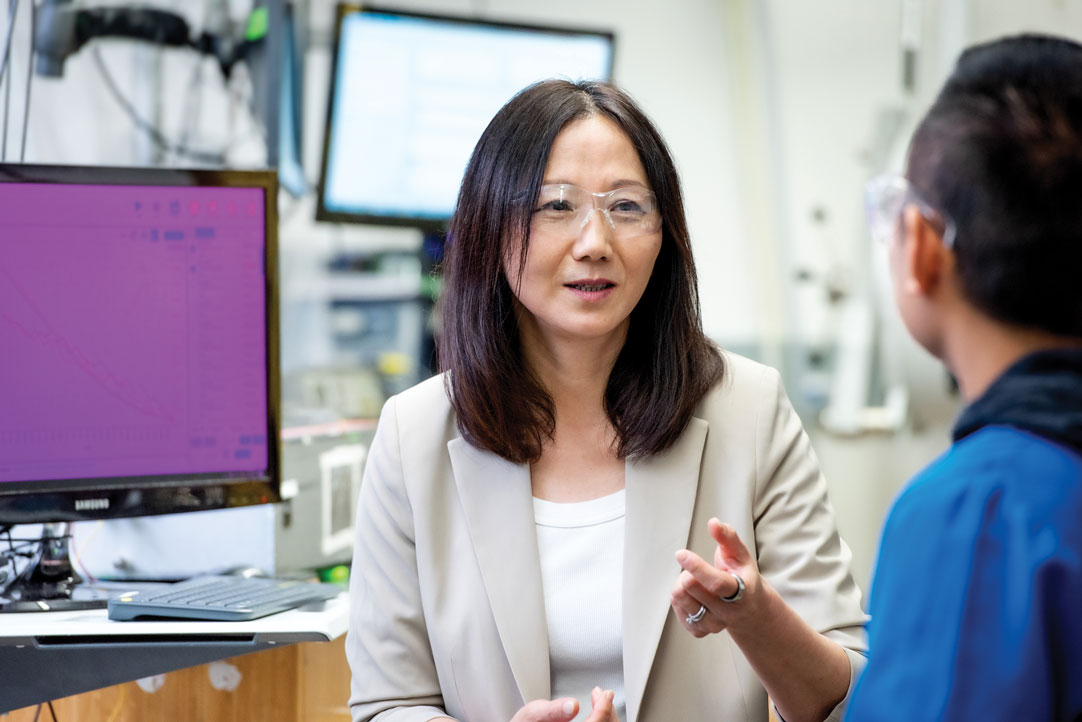

Anyone who has ever dreaded ripping off a Band-Aid—let alone re-dressing a serious wound—will have an easy appreciation for a recent invention from the labs of Stanford chemical engineering professor Zhenan Bao and professor emeritus of surgery Geoffrey Gurtner. The prototype device—a smart bandage that adheres to the body with a supple, conductive hydrogel—painlessly falls away from the skin when warmed to a few degrees above normal body temperature by, say, a blow dryer. A nation’s arm hairs stand in salute.
That’s only one of its powers. The bandage, which gleans energy from radio frequencies, also tracks signs of recovery and infection and responds with electrical stimulation to hasten healing. In animal studies, the bandage resulted in 25 percent faster healing, greater blood flow to injured tissue, and less scarring. Though far from pharmacy shelves—the prototype was built at mouse scale—future versions of the bandage might one day help people with chronic wounds due to suppressed immune systems or diseases like diabetes, or those with burns. Not bad for a wire-free, stick-on device whose healing hydrogel is not much thicker than a coat of latex paint.
The bandage is one example of how Bao and her colleagues combine organic chemistry and the engineering of novel materials to reimagine medical devices in more powerful, personal, and unobtrusive ways. They have developed heart sensors that adhere like postage stamps to the beating organ to locate atrial fibrillation; wireless sensors to monitor tumor growth; and soft, implantable sensors that tuck harmlessly into brain and gut tissues to measure dopamine and serotonin levels. Of particular importance to Bao, given the mental health struggles she has seen among her own friends and family, is the stick-on sensor her lab is developing that measures skin conductivity, heart rate variance, and cortisol levels—all corollaries of anxiety and stress. It could give psychiatrists new metrics to assess depression.
As intriguing as these devices might be, they are in some ways simply byproducts of a grander pursuit that has occupied Bao since she joined the Stanford faculty in 2004. She was coming off nearly a decade in industrial research at Bell Labs, where she did pioneering work on flexible electronics—including developing the materials that went into the first flexible “electronic paper,” a precursor to the bendable screens now seen in some smartphones. With a fresh start in academia, Bao wanted to reset her sights further into the future. One of her new colleagues, professor of mechanical engineering Mark Cutkosky, was then building robotic cockroaches able to climb walls as deftly as real insects. The bugs, however, lacked accurate sensory feedback to know when they’d reached the top, and would plunge back to the ground. That got Bao interested in creating skin-like sensors that could feel touch. In turn, she soon began trying to mimic the broader range of powers that make skin the ultimate wearable electronic system.
As mundane as our largest organ might seem to those of us thoughtlessly walking around in it, skin is an almost magical material, capable of sensing, conducting, bending, stretching, healing, decomposing, and communicating with our brains. Initially, Bao says, she worried she had laid down too lofty an aim. Would trying to unify so many capabilities in a single device be too much? But she decided it was better to be bold. “I thought, if we don’t set down an ambitious goal, we will never get to it.”
In the nearly two decades since, her lab has made steady gains. It now produces basic versions of self-healing, biodegradable electronic skin—it looks like latex—that can function when stretched to twice its original length, has the sensitivity to “feel” the footsteps of a ladybug, and can convert those signals into electronic pulses that are intelligible to neurons. The final goal—which could one day bring sensation to people who use prosthetics—remains in the distance. Meanwhile, Bao says, skin serves as target, motivation, and inspiration. “It allows my students to be more creative because they can see this is the bigger picture,” she says. “Then they can say, ‘We are missing this part of skin function,’ or ‘As a material, skin has this property. Why don’t we also incorporate that?’ ”
It’s in the pursuit of this larger goal—to mimic skin’s abilities—that her lab has achieved the breakthroughs that spin off into smaller devices, like the smart bandage with conductive hydrogel, or noninvasive blood pressure monitors for neonates, which apply her e-skin concept’s ability to feel. The performance of these devices then inspires ways to keep improving the fundamental chemistry behind the lab’s advanced materials, the area of research that concerns Bao more than any individual invention. It’s a feedback loop that Bao sees leading to a new paradigm of inconspicuous, autonomous medical devices that blur the line between human and machine by harmoniously operating on—and in—our bodies’ most delicate regions.
Original Skin
Fiction writers have long been fascinated with the notion of blending human and technology, from the screwed-together war general in Edgar Allen Poe’s The Man Who Was Used Up to Luke Skywalker’s lifelike prosthetic replacement for the hand lost to Darth Vader’s lightsaber. Making such feats of imagination real comes with serious challenges, not least how to connect the devices with the nervous system. But even more modest bioelectronics, like sensors or bandages, face another fundamental challenge: The soft, curved, moving tissues of a living body don’t marry well with the ungiving, brittle, inorganic ingredients that are core to most advanced technologies. Hardware, it turns out, is well named. As are computer chips, made of the flinty and flexless silicon wafer.
To bypass this compatibility problem, some engineers—particularly John Rogers, a materials scientist at Northwestern University—have developed ingenious ways to adapt traditional copper-and-silicon devices to the body. Rogers, once Bao’s colleague at Bell Labs, has minted nanoscale geometries—using serpentine patterns and ever thinner slices—to induce flexible behavior in inherently inflexible materials. In 2021, for example, Rogers published a paper on the first “transient” pacemaker—a wireless, battery-free prototype tested in animals that dissolves when no longer needed, obviating the need for a second surgery to remove the device.

FLESHING IT OUT: Bao's lab produces basic versions of self-healing, biodegradable electronic skin. [Images from top: Courtesy Jiancheng Lai/Yuanwen Jiang/Zhenan Bao/Stanford University (2); Barbara Ries]
While Rogers pares down the established ingredients of technology to make them more compatible with our bodies, Bao is known for the opposite approach: building up biocompatible materials from the molecular level. As an organic chemist, Bao is expert in designing and synthesizing new polymers—long molecular chains of repeating units—like plastics, which generally have such poor conductivity that their established place in the electronic world is as insulators.
Indeed, while the tightly packed atomic lattices in silicon crystals form a virtual superhighway for electrical charges, polymers are more like meandering country roads. But scientists have far greater ability to tinker with carbon-based organic materials—which include synthetics like plastic—than they do inorganic substances like silicon. And over years of experimentation with molecular make-up and with the way the polymers are arranged, Bao’s lab has created plastics that have narrowed—though certainly not closed—the performance gap with silicon. In Bao’s words, they’ve harnessed something called the nanoconfinement effect to make these country roads less bumpy and winding. At the same time, they’ve also been able to make the materials stretchable, self-healing, and biodegradable. The result: Bao’s lab has reinvented the familiar guts of technology—semiconductors, sensors, even integrated circuits—out of flexible, inherently stretchable plastic. “It takes an amazing amount of design, molecular design, to create the chemistries that achieve that,” says Joe DeSimone, a Stanford professor of chemical engineering. “And she has done that.”
As mundane as our largest organ might seem to those of us thoughtlessly walking around in it, skin is an almost magical material, capable of sensing, conducting, bending, stretching, healing, decomposing, and communicating with our brains.
“I recall thinking a long time ago that, well, you know, that would be interesting, but, gosh, there’s a lot of things that have to be solved,” says Curtis Frank, who recently retired as a professor in the chemical engineering department. “She just solved them all.”
As a practical matter, the adaptive approach to bioelectronics blazed by Rogers may have bigger real-world impact in the near term, DeSimone says. It’s easier to push known materials to new limits than to create new ones, not to mention to fabricate them at scale. “There’s very little [Bao] can leverage,” he says. “She has to create it all herself.” In time, though, he says, Bao’s soft, organic, stretchable electronics—a closer fit to our natural tissues and therefore less likely to trigger the body’s rejection of foreign bodies—may represent the ultimate solution. “That’s the way the body works on a molecular level.”
Bao’s novel materials and devices aren’t even the most out-there concept she’s working on. In collaboration with professor of bio-engineering and of psychiatry and behavioral sciences Karl Deisseroth, PhD ’98, MD ’00, and professor of chemistry Carolyn Bertozzi, Bao’s lab is exploring genetically altering cells to make their own polymers. That capability might allow scientists to one day grow conductive polymers atop misfiring neurons to treat conditions like epilepsy, or even grow devices like sensors within the body. The approach may also provide a way for a future version of electronic skin to communicate directly with a particular nerve. “If we can choose which nerve to change its electrical properties, then potentially we can wirelessly communicate to that nerve only,” Bao says.
The verve of Bao’s vision—to go her own way, to make new materials—has made her a magnet for top grad students and researchers, such as Helen Tran, now an assistant professor at the University of Toronto, who came to Bao’s lab as a postdoc, drawn by Bao’s creativity. “I wanted to work at the cutting edge with who’s doing the crazy things,” Tran says. “It’s just more fun as a chemist to really dream big on these crazy, sci-fi-like ideas. She is really trying to change the paradigm.”
The potential impact goes beyond medical devices. Imagine, Tran says, a day when you don’t have to carry a phone or a wallet—you can just put a temporary tattoo on your hand, or wear a bracelet, that can do all the jobs those items would do. “Imagine all the functionality but less of a burden to you,” Tran says. “I think she is creating the first step to that dream.”
Scientific Methods
Bao was born in Nanjing, China, into a household of science. Her dad was a solid-state physicist and her mother was a chemist. Bao remembers growing up surrounded by the accoutrements of their academic lives, like squeeze bottles of distilled water, pH paper, and variegated silicon wafers. More than their formal knowledge, Bao credits her parents for passing on a curiosity about the world. Her father, particularly, liked to engage Bao with questions about their surroundings, taking delight as her own questions revealed how much thought she was already giving subjects. In Nanjing’s hot, sticky summers, he would treat her to the occasional popsicle. Once, when she was around 4, he asked her what would happen if she threw it in the park pond. When she said it would sink, he urged her to test her hypothesis—encouraging her with a promise to replace the treat. “That’s how I learned that water is denser than ice,” she says.
Her parents didn’t put pressure on her as a student, in part, they later told her, because she was so obviously putting so much on herself. Chemistry took its hold on her in high school. It reminded her of cooking. And by the time she enrolled at Nanjing University, she had started to excel, thanks in part to a mental trick. After floundering initially, she discovered that if she practiced an imaginary experiment before she performed a real one, it would feel almost as if she had done it before. “In the organic chemistry lab, we were graded by how much of a compound [we] could produce, and I always had the highest yield,” she told the National Science Foundation in 2017. “I found I was really good at this.”

She sought other mental advantages. Feeling intimidated by the talent around her—and being two years younger than most in her academic year—she discovered a book that stressed the importance of time management. It resonated. To the extent she admits any special talent today, it’s efficiency. If she’s cooking, she’s cooking four things. If she’s watching the news, she’s also clearing her inbox. If she’s hiking with her husband, chemical engineering lab director Jeffrey Tok, they’re probably talking about work. If she’s advising students, they often join her on her walk to or from the lab. “My brain is constantly optimizing what task I can fit in most efficiently so that I get the best productivity out of the same amount of time,” Bao says.
‘It’s just more fun as a chemist to really dream big on these crazy, sci-fi-like ideas. She is really trying to change the paradigm.’
When Bao was midway through her undergraduate studies, her family decided that she and her older sister would immigrate to the United States for better educational opportunities. So in 1990, at age 19, Bao dropped out of college and moved with her sister to Chicago with about one month’s rent in hand. Over the next six months, she worked as a bagger at a grocery store (her English, she says, wasn’t good enough for her to be a cashier) and as an inspector at a factory making binder partitions (her job was to make sure the dividers were sorted correctly) while studying at a community college. Then she took classes at the University of Illinois Chicago. In 1991, on the strength of her GRE scores and her academic record, including two Nanjing University awards for exceptional work in chemistry, she was admitted to the University of Chicago as a grad student. Her CV—which each year gleams with new awards—lacks that most common line item in academia: a bachelor’s degree.
It was at the University of Chicago and especially at Bell Labs, where she worked hand-in-hand with electrical engineers and physicists, that she learned the importance of interdisciplinary collaboration, a hallmark of her science. Today, her interests place her at the intersection of engineering, science, and medicine, which requires a small army of specialists. Her lab—which numbers some 50 PhD students and postdocs and a dozen more students and visiting scholars—includes chemists, materials scientists, chemical engineers, electrical engineers, mechanical engineers, and bioengineers. “She has basically a whole science-and-engineering wonderland of experts in her group,” Frank says. And while her lab produces novel materials and devices with new characteristics, it is often only after talking with professors, postdocs, and researchers at the Medical School and in other departments that her team realizes how best to apply them.
In 2016, to expand such collaborations, Bao founded the Stanford Wearable Electronics Initiative, aka Stanford eWEAR, to create a forum for researchers across Stanford and in private industry to exchange ideas and to work with one another. The resulting cooperation is invaluable, says Xiang Qian, a Stanford clinical professor of anesthesiology who is working on a wearable nerve stimulator he hopes will address chronic migraines. There is too much science, engineering, and medicine involved for any one professor to address the problem alone. And if Qian has any unresolved questions, Bao is always willing to jump in herself. “You can call her anytime, text, email,” he says. “She’s like, ‘Let’s go grab lunch together. Let’s have a Zoom call meeting.’ She’s there. She’s available for you.”
Skin in the Game
Although Bao can imagine her science in many a commercial realm—tattoo credit cards included—her own attention is first and foremost on medicine. Her lab has been working for more than six years on the stick-on patch to detect physiological signs of depression, a challenge that required developing a way to take continuous cortisol measurements from minute amounts of sweat. (Bao likens the task to measuring a pinch of salt in an Olympic swimming pool.) She has been motivated to continue largely because of experiences in her own personal circle. “Everyone has a story of their friend or their family member impacted by mental health [challenges],” she says. “I want to work on applications that help the most people.”
For another project, her lab published a paper in January describing a polyurethane smart skin that sprays on like sunscreen, covering one’s skin with a mesh of millions of electrically sensitive nanowires that remain until washed off with soap. Artificial intelligence is then able to associate finger movements with tasks, allowing a user to, say, type without a keyboard. The spray-on nature of the device has the potential to be adapted to the face to capture emotional cues that could improve computer animation or avatar-led virtual meetings. It’s a foreshadowing of some of the utilitarian roles Bao sees for electronic skin. In the near future, she envisions skin that will provide trainee surgeons and others learning fine-grained tasks with exact feedback that allows them to precisely know the pressure, angle, and speed with which to make a motion.
While the road from lab to market is long and uncertain, this year, for the first time, a medical device inspired by Bao’s research is expected to get FDA approval: a bracelet/anklet with a sense of touch so refined it can provide continual noninvasive blood pressure readings on the smallest premature babies. Traditionally, the best way to measure blood pressure precisely and continuously in neonates is through arterial catheters, which can be painful, are difficult to set, and carry mortality risks. “Once it catches on, I think people will say, ‘Why poke when we can just get by with this?’ ” says Anoop Rao, a clinical assistant professor of pediatrics and the Stanford site’s principal investigator for the clinical study of the device.
Back when he was chair of the chemical engineering department, Frank says he knew Bao was coming down the hall by the speed of her steps. “She is always moving,” he says. Bao’s lab operates with similar energy. Paige Fox, an associate professor of surgery at the School of Medicine, worked with Bao for years to create a wireless blood-flow sensor that wraps around an artery to monitor bypasses, then biodegrades when it’s no longer needed. The resulting device, Fox says, impressed her with its acute sensitivity in animal and cadaver models. But what was perhaps most striking was how hard Bao’s postdocs and grad students hustled. “People always joke about academics being slow compared to industry,” Fox says. “When I would go back to her and her researchers with a problem, and I’d say, ‘Hey, you know, this is not going to work the way it is,’ it wasn’t months before they came back with something else. It was next week. The pace of development of technology over there is amazing.”
The Science of Skin - by Sam Scott, Photography by Barbara Ries - Stanford Magazine - March 2023


